
Anostostomatidae is a family of insects in the order Orthoptera, widely distributed in the southern hemisphere. It is named Mimnermidae or Henicidae in some taxonomies, and common names include king crickets in Australia and South Africa, and wētā in New Zealand. Prominent members include the Parktown prawn of South Africa, and the giant wētā of New Zealand.

Acrididae are the predominant family of grasshoppers, comprising some 10,000 of the 11,000 species of the entire suborder Caelifera. The Acrididae are best known because all locusts are of the Acrididae. The subfamily Oedipodinae is sometimes classified as a distinct family Oedipodidae in the superfamily Acridoidea. Acrididae grasshoppers are characterized by relatively short and stout antennae, and tympana on the side of the first abdominal segment.

The Euphasmatodea, also known by its junior synonym Verophasmatodea is a suborder of the Phasmatodea, which contains the vast majority of the extant species of stick and leaf insects, excluding the Timematodea. The oldest record of Euphasmatodea is Araripephasma from the Crato Formation of Brazil, dating to the Aptian stage of the Early Cretaceous.

Gryllacrididae are a family of non-jumping insects in the suborder Ensifera occurring worldwide, known commonly as leaf-rolling crickets or raspy crickets. The family historically has been broadly defined to include what are presently several other families, such as Stenopelmatidae and Rhaphidophoridae, now considered separate. As presently defined, the family contains two subfamilies: Gryllacridinae and Hyperbaeninae. They are commonly wingless and nocturnal. In the daytime, most species rest in shelters made from folded leaves sewn with silk. Some species use silk to burrow in sand, earth or wood. Raspy crickets evolved the ability to produce silk independently from other insects, but their silk has many convergent features to silkworm silk, being made of long, repetitive proteins with an extended beta-sheet structure.
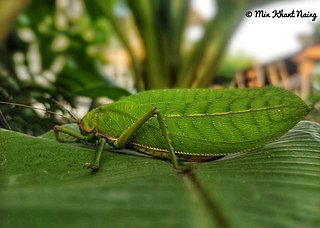
The subfamily Pseudophyllinae contains numerous species in the family Tettigoniidae, the katydids or bush crickets. Sometimes called "true katydids", together with the crickets of suborder Ensifera, they form part of the insect order Orthoptera which also contains grasshoppers.

The Phaneropterinae, the sickle-bearing bush crickets or leaf katydids, are a subfamily of insects within the family Tettigoniidae. They are also known as false katydids or round-headed katydids.

Scudderia is a genus of katydids in the subfamily Phaneropterinae. They are sometimes called bush katydids and are 30–38 mm in length. Their range is most of North America, northernmost being in Southern Canada. They are herbivores, with nymphs feeding primarily on flowers and adults preferring woody deciduous plants.

Gryllidea is an infraorder that includes crickets and similar insects in the order Orthoptera. There are two superfamilies, and more than 6,000 described species in Gryllidea.
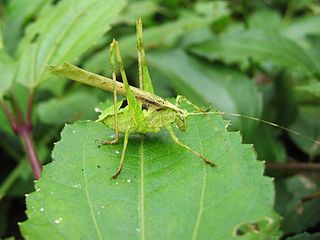
Insara, commonly known as western bush katydids, is a genus of katydids in the family Tettigoniidae.
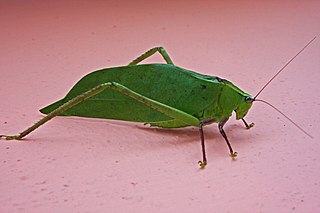
Stilpnochlora is a genus of phaneropterine katydids in the family Tettigoniidae, native to tropical and subtropical parts of the Americas. There are about 15 described species in Stilpnochlora.
Turpilia is a genus of phaneropterine katydids in the family Tettigoniidae. There are about nine described species in Turpilia.

Aidemona is a genus of spur-throated grasshoppers in the family Acrididae. There are about five described species in Aidemona.
Himertula is a genus of bush crickets in the subfamily Phaneropterinae and tribe Letanini. Species can be found mostly in the Indian sub-continent.

Caedicia is a genus of bush crickets or katydids in the subfamily Phaneropterinae. Species can be found Australasia, with records from Vietnam, Papua New Guinea, and Australia.
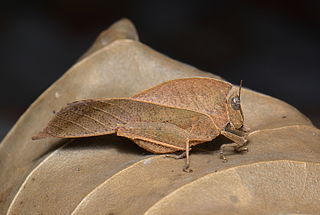
Chorotypus is a genus of Asian grasshoppers in the family Chorotypidae; species can be found in: India, Indochina and Malesia.
Zulpha is a monotypic genus of bush crickets containing only the species Zulpha perlaria.

Paragryllacris is a genus of Australian Orthopterans, sometimes known as 'leaf-folding crickets' in the family Gryllacridinae, erected by the Swiss entomologist Carl Brunner von Wattenwyl in 1888. It is fairly typical for its tribe Paragryllacridini. However, in a large comparison of 650 insect species, Australian Raspy Crickets were found to be the insect with the strongest bite.
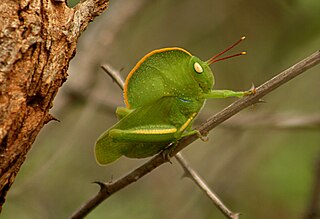
Teratodinae is a subfamily of grasshoppers in the family Acrididae. There are about 8 genera and more than 20 described species, found in East Africa and South-West Asia.
Melanonotus is a genus of katydid insects in the family Tettigoniidae.

Parapachymorpha is a genus of stick insects in the tribe Medaurini, erected by Carl Brunner von Wattenwyl in 1893. Species have been recorded from: China, Myanmar, Thailand, Cambodia and Vietnam.
















